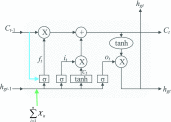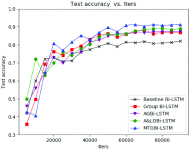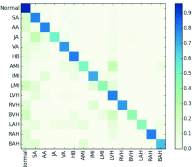A Multi-Task Group Bi-LSTM Networks Application on Electrocardiogram Classification
- PMID: 32082952
- PMCID: PMC7028438
- DOI: 10.1109/JTEHM.2019.2952610
A Multi-Task Group Bi-LSTM Networks Application on Electrocardiogram Classification
Abstract
Background: Cardiovascular diseases (CVD) are the leading cause of death globally. Electrocardiogram (ECG) analysis can provide thoroughly assessment for different CVDs efficiently. We propose a multi-task group bidirectional long short-term memory (MTGBi-LSTM) framework to intelligent recognize multiple CVDs based on multi-lead ECG signals.
Methods: This model employs a Group Bi-LSTM (GBi-LSTM) and Residual Group Convolutional Neural Network (Res-GCNN) to learn the dual feature representation of ECG space and time series. GBi-LSTM is divided into Global Bi-LSTM and Intra-Group Bi-LSTM, which can learn the features of each ECG lead and the relationship between leads. Then, through attention mechanism, the different lead information of ECG is integrated to make the model to possess the powerful feature discriminability. Through multi-task learning, the model can fully mine the association information between diseases and obtain more accurate diagnostic results. In addition, we propose a dynamic weighted loss function to better quantify the loss to overcome the imbalance between classes.
Results: Based on more than 170,000 clinical 12-lead ECG analysis, the MTGBi-LSTM method achieved accuracy, precision, recall and F1 of 88.86%, 90.67%, 94.19% and 92.39%, respectively. The experimental results show that the proposed MTGBi-LSTM method can reliably realize ECG analysis and provide an effective tool for computer-aided diagnosis of CVD.
Keywords: ECG; attention mechanism; bidirectional long short-term memory network; multi-task learning.
Figures







Similar articles
-
A robust multiple heartbeats classification with weight-based loss based on convolutional neural network and bidirectional long short-term memory.Front Physiol. 2022 Dec 5;13:982537. doi: 10.3389/fphys.2022.982537. eCollection 2022. Front Physiol. 2022. PMID: 36545286 Free PMC article.
-
A Hybrid Deep Learning Approach for ECG-Based Arrhythmia Classification.Bioengineering (Basel). 2022 Apr 2;9(4):152. doi: 10.3390/bioengineering9040152. Bioengineering (Basel). 2022. PMID: 35447712 Free PMC article.
-
An improved Bi-LSTM method based on heterogeneous features fusion and attention mechanism for ECG recognition.Comput Biol Med. 2024 Feb;169:107903. doi: 10.1016/j.compbiomed.2023.107903. Epub 2023 Dec 28. Comput Biol Med. 2024. PMID: 38171263
-
ECG data enhancement method using generate adversarial networks based on Bi-LSTM and CBAM.Physiol Meas. 2024 Feb 12;45(2). doi: 10.1088/1361-6579/ad2218. Physiol Meas. 2024. PMID: 38266299
-
An End-to-End Multi-Channel Convolutional Bi-LSTM Network for Automatic Sleep Stage Detection.Sensors (Basel). 2023 May 21;23(10):4950. doi: 10.3390/s23104950. Sensors (Basel). 2023. PMID: 37430865 Free PMC article.
Cited by
-
Recent Advancements and Perspectives in the Diagnosis of Skin Diseases Using Machine Learning and Deep Learning: A Review.Diagnostics (Basel). 2023 Nov 22;13(23):3506. doi: 10.3390/diagnostics13233506. Diagnostics (Basel). 2023. PMID: 38066747 Free PMC article. Review.
-
TCMBank: bridges between the largest herbal medicines, chemical ingredients, target proteins, and associated diseases with intelligence text mining.Chem Sci. 2023 Aug 8;14(39):10684-10701. doi: 10.1039/d3sc02139d. eCollection 2023 Oct 11. Chem Sci. 2023. PMID: 37829020 Free PMC article.
-
A High-Performance Anti-Noise Algorithm for Arrhythmia Recognition.Sensors (Basel). 2024 Jul 14;24(14):4558. doi: 10.3390/s24144558. Sensors (Basel). 2024. PMID: 39065956 Free PMC article.
-
Classification of IHC Images of NATs With ResNet-FRP-LSTM for Predicting Survival Rates of Rectal Cancer Patients.IEEE J Transl Eng Health Med. 2022 Dec 15;11:87-95. doi: 10.1109/JTEHM.2022.3229561. eCollection 2023. IEEE J Transl Eng Health Med. 2022. PMID: 36704244 Free PMC article.
-
Prediction and Diagnosis of Respiratory Disease by Combining Convolutional Neural Network and Bi-directional Long Short-Term Memory Methods.Front Public Health. 2022 May 4;10:881234. doi: 10.3389/fpubh.2022.881234. eCollection 2022. Front Public Health. 2022. PMID: 35602136 Free PMC article.
References
-
- World Health Organization, Mendis S., Puska P., and Norrving B., Global Atlas on Cardiovascular Disease Prevention and Control. Geneva, Switzerland: World Health Organization, 2011, pp. 3–18.
-
- McGill H. C., McMahan C. A., and Gidding S. S., “Preventing heart disease in the 21st century: Implications of the pathobiological determinants of atherosclerosis in youth (PDAY) study,” Circulation, vol. 117, no. 9, pp. 1216–1227, Mar. 2008. - PubMed
LinkOut - more resources
Full Text Sources
Other Literature Sources

